《英语修辞格》
- 格式:ppt
- 大小:586.50 KB
- 文档页数:28
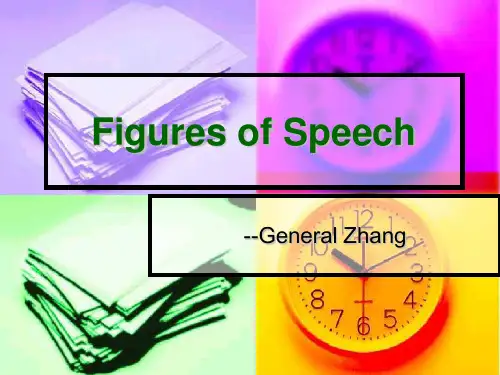

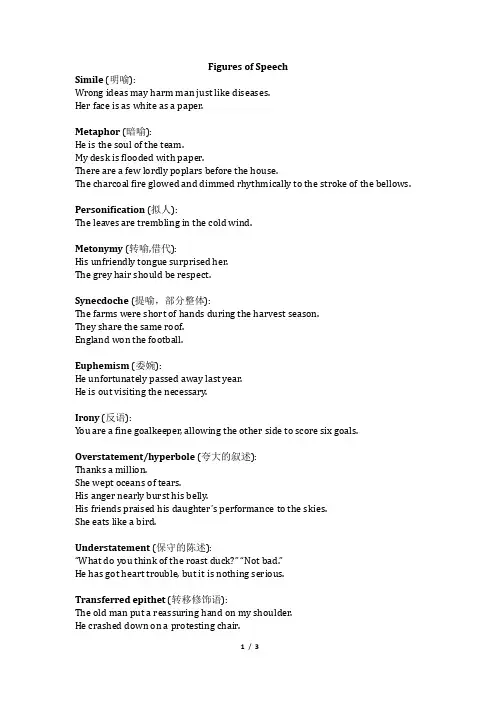
Figures of SpeechSimile (明喻):Wrong ideas may harm man just like diseases.Her face is as white as a paper.Metaphor (暗喻):He is the soul of the team.My desk is flooded with paper.There are a few lordly poplars before the house.The charcoal fire glowed and dimmed rhythmically to the stroke of the bellows. Personification (拟人):The leaves are trembling in the cold wind.Metonymy (转喻,借代):His unfriendly tongue surprised her.The grey hair should be respect.Synecdoche (提喻,部分整体):The farms were short of hands during the harvest season.They share the same roof.England won the football.Euphemism (委婉):He unfortunately passed away last year.He is out visiting the necessary.Irony (反语):You are a fine goalkeeper, allowing the other side to score six goals. Overstatement/hyperbole (夸大的叙述):Thanks a million.She wept oceans of tears.His anger nearly burst his belly.His friends praised his daughter’s performance to the skies.She eats like a bird.Understatement (保守的陈述):“What do you think of the roast duck?” “Not bad.”He has got heart trouble, but it is nothing serious.Transferred epithet (转移修饰语):The old man put a reassuring hand on my shoulder.He crashed down on a protesting chair.Oxymoron (矛盾修饰法):She read the long-awaited letter with a tearful smile.Parting is such a sweet sorrow.Alliteration (头韵):Time and tide wait for no man.Pun (双关):They pray for you today and prey on you tomorrow.Women have a wonderful sense of right and wrong, but little sense of right and left.Customer: Waiter, will the pancakes be long? -Waiter: No, sir, round.In the window of a hearing-aid shop: “Trust us, over 5000 ears (years) of experience.”-Why can you never expect a fisherman to be so generous?-Because his business makes him sell fish (selfish).Analogy (类比):Knowledge is to the mind what nutrition is to the body.Antonomasia (换称, 专有名词代普通名词,人名、地名):He spent the whole winter in the Windy City. (Chicago)Shanghai is the New York of China.Allusion (暗示):Grammar may be his heel of Achilles.语法是他的大弱点。

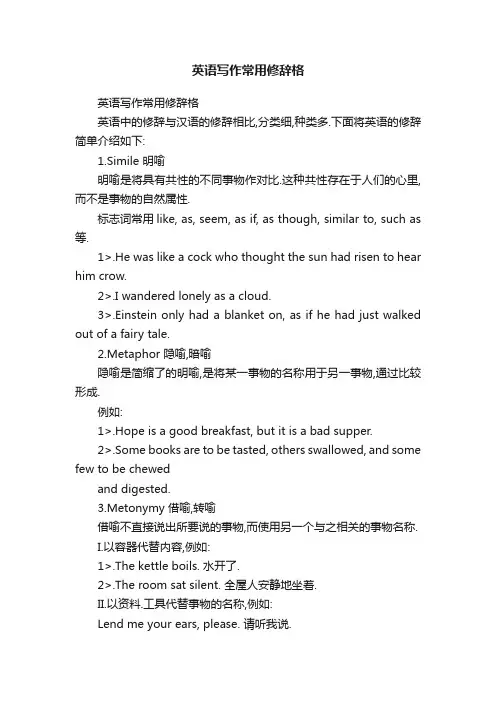
英语写作常用修辞格英语写作常用修辞格英语中的修辞与汉语的修辞相比,分类细,种类多.下面将英语的修辞简单介绍如下:1.Simile 明喻明喻是将具有共性的不同事物作对比.这种共性存在于人们的心里,而不是事物的自然属性.标志词常用like, as, seem, as if, as though, similar to, such as 等.1>.He was like a cock who thought the sun had risen to hear him crow.2>.I wandered lonely as a cloud.3>.Einstein only had a blanket on, as if he had just walked out of a fairy tale.2.Metaphor 隐喻,暗喻隐喻是简缩了的明喻,是将某一事物的名称用于另一事物,通过比较形成.例如:1>.Hope is a good breakfast, but it is a bad supper.2>.Some books are to be tasted, others swallowed, and some few to be chewedand digested.3.Metonymy 借喻,转喻借喻不直接说出所要说的事物,而使用另一个与之相关的事物名称.I.以容器代替内容,例如:1>.The kettle boils. 水开了.2>.The room sat silent. 全屋人安静地坐着.II.以资料.工具代替事物的名称,例如:Lend me your ears, please. 请听我说.III.以作者代替作品,例如:a complete Shakespeare 莎士比亚全集VI.以具体事物代替抽象概念,例如:I had the muscle, and they made money out of it.我有力气,他们就用我的力气赚钱.4.Synecdoche 提喻提喻用部分代替全体,或用全体代替部分,或特殊代替一般.1>.There are about 100 hands working in his factory.他的厂里约有100名工人.2>.He is the Newton of this century.他是本世纪的牛顿.3>.The fox goes very well with your cap.这狐皮围脖与你的帽子很相配.5.Synaesthesia 通感,联觉,移觉这种修辞法是以视.听.触.嗅.味等感觉直接描写事物.1>.The birds sat upon a tree and poured forth their lily like voice.鸟儿落在树上,倾泻出百合花似的声音.2>.Taste the music of Mozart.品尝Mozart的音乐.6.Personification 拟人拟人是把生命赋予无生命的事物.例如:1>.The night gently lays her hand at our fevered heads.2>.I was very happy and could hear the birds singing in the woods.8.Parallelism 排比, 平行这种修辞法是把两个或两个以上的结构大体相同或相似,意思相关,语气一致的短语. 句子排列成串,形成一个整体.例如:1>.No one can be perfectly free till all are free; no one can be perfectly moraltill all are moral; no one can be perfectly happy till all are happy.9.Euphemism 委婉,婉辞法婉辞法指用委婉,文雅的方法表达粗恶,避讳的话.例如:1>.He is out visiting the necessary.他出去方便一下.2>.His relation with his wife has not been fortunate.他与妻子关系不融洽.3>.Deng Xiaoping passed away in 1997.11.Irony 反语反语指用相反意义的词来表达意思的作文方式.如在指责过失.错误时,用赞同过失的说法,而在表扬时,则近乎责难的说法.1>.It would be a fine thing indeed not knowing what time it was in the morning.2>"Of course, you only carry large notes, no small change on you. "the waitersaid to the beggar.12.Pun 双关双关就是用一个词在句子中的双重含义,借题发挥.作出多种解释,旁敲侧击,从而达到意想不到的幽默.滑稽效果.它主要以相似的词形.词意和谐音的方式出现.2>.An ambassador is an honest man who lies abroad for the good of his country.3>.If we don't hang together, we shall hang separately.13.Parody 仿拟这是一种模仿名言.警句.谚语,改动其中部分词语,从而使其产生新意的修辞.1>.Rome was not built in a day, nor in a year.14.Rhetorical question 修辞疑问它与疑问句的不同在于它并不以得到答复为目的,而是以疑问为手段,取得修辞上的效果,其特点是:肯定问句表示强烈否定,而否定问句表示强烈的肯定.它的答案往往是不言而喻的.1>.How was it possible to walk for an hour through the woods and see nothingworth of note?2>.Shall we allow those untruths to go unanswered?15.Antithesis 对照,对比,对偶这种修辞指将意义完全相反的语句排在一起对比的一种修辞方法.1>.Not that I loved Caeser less but that I loved Romemore.2>.You are staying; I am going.3>.Give me liberty, or give me death.16.Paradox 隽语这是一种貌似矛盾,但包含一定哲理的意味深长的说法,是一种矛盾修辞法..例如:1>.More haste, less speed.2>.The child is the father to the man.18.Climax 渐进法,层进法这种修辞是将一系列词语按照意念的大小.轻重.深浅.高低等逐层渐进,最后达到顶点.可以增强语势,逐渐加深读者印象.1>.I am sorry, I am so sorry, I am so extremely sorry.2>.Eye had not seen nor ear heard, and nothing had touched his heart of stone.19.Anticlimax 渐降法与climax相反的一种修辞法,将一系列词语由大到小,由强到弱地排列.1>.On his breast he wears his decorations, at his side a sword, on his feeta pair of boots.2>.The duties of a soldier are to protect his country and peel potatoes.明喻(simile)是以两种具有相同特征的事物和现象进行对比表明本体和喻体之间的相似关系两者都在对比中出现。
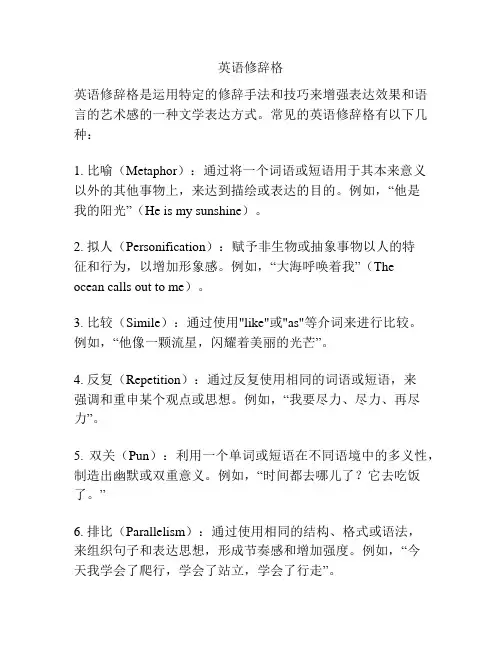
英语修辞格英语修辞格是运用特定的修辞手法和技巧来增强表达效果和语言的艺术感的一种文学表达方式。
常见的英语修辞格有以下几种:1. 比喻(Metaphor):通过将一个词语或短语用于其本来意义以外的其他事物上,来达到描绘或表达的目的。
例如,“他是我的阳光”(He is my sunshine)。
2. 拟人(Personification):赋予非生物或抽象事物以人的特征和行为,以增加形象感。
例如,“大海呼唤着我”(The ocean calls out to me)。
3. 比较(Simile):通过使用"like"或"as"等介词来进行比较。
例如,“他像一颗流星,闪耀着美丽的光芒”。
4. 反复(Repetition):通过反复使用相同的词语或短语,来强调和重申某个观点或思想。
例如,“我要尽力、尽力、再尽力”。
5. 双关(Pun):利用一个单词或短语在不同语境中的多义性,制造出幽默或双重意义。
例如,“时间都去哪儿了?它去吃饭了。
”6. 排比(Parallelism):通过使用相同的结构、格式或语法,来组织句子和表达思想,形成节奏感和增加强度。
例如,“今天我学会了爬行,学会了站立,学会了行走”。
7. 夸张(Hyperbole):通过夸大事物的特征和情况,来制造出夸张、强烈的效果。
例如,“我等了一万年才见到你”。
8. 反问(Rhetorical Question):利用问句的形式来表达观点或意见,不要求回答,但更多是用来强调说话者的说法。
例如,“难道我们不都是人吗?”这些修辞格可以增加语言的表达力、形象感、感染力和艺术感,使文学作品或演讲更具有吸引力和影响力。
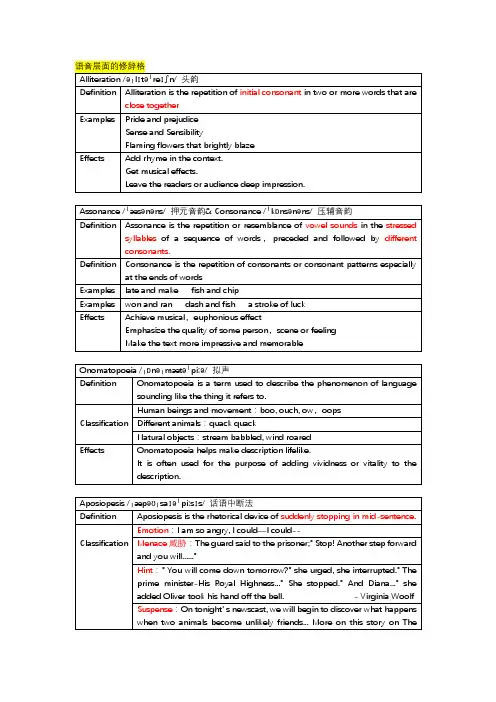
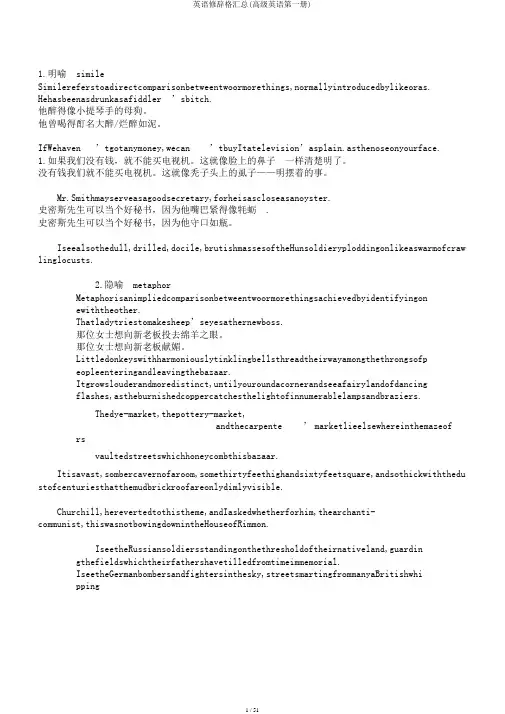
1.明喻simileSimilereferstoadirectcomparisonbetweentwoormorethings,normallyintroducedbylikeoras. Hehasbeenasdrunkasafiddler ’sbitch.他醉得像小提琴手的母狗。
他曾喝得酊名大醉/烂醉如泥。
IfWehaven ’tgotanymoney,wecan’tbuyItatelevision’asplain.asthenoseonyourface.1.如果我们没有钱,就不能买电视机。
这就像脸上的鼻子一样清楚明了。
没有钱我们就不能买电视机。
这就像秃子头上的虱子——明摆着的事。
Mr.Smithmayserveasagoodsecretary,forheisascloseasanoyster.史密斯先生可以当个好秘书,因为他嘴巴紧得像牦蛎.史密斯先生可以当个好秘书,因为他守口如瓶。
Iseealsothedull,drilled,docile,brutishmassesoftheHunsoldieryploddingonlikeaswarmofcraw linglocusts.2.隐喻metaphorMetaphorisanimpliedcomparisonbetweentwoormorethingsachievedbyidentifyingonewiththeother.Thatladytriestomakesheep’seyesathernewboss.那位女士想向新老板投去绵羊之眼。
那位女士想向新老板献媚。
Littledonkeyswithharmoniouslytinklingbellsthreadtheirwayamongthethrongsofpeopleenteringandleavingthebazaar.Itgrowslouderandmoredistinct,untilyouroundacornerandseeafairylandofdancingflashes,astheburnishedcoppercatchesthelightofinnumerablelampsandbraziers.Thedye-market,thepottery-market,’marketlieelsewhereinthemazeofandthecarpentersvaultedstreetswhichhoneycombthisbazaar.Itisavast,sombercavernofaroom,somethirtyfeethighandsixtyfeetsquare,andsothickwiththedu stofcenturiesthatthemudbrickroofareonlydimlyvisible.Churchill,herevertedtothistheme,andIaskedwhetherforhim,thearchanti-communist,thiswasnotbowingdownintheHouseofRimmon.IseetheRussiansoldiersstandingonthethresholdoftheirnativeland,guardin gthefieldswhichtheirfathershavetilledfromtimeimmemorial.IseetheGermanbombersandfightersinthesky,streetsmartingfrommanyaBritishwhippingButallthisfadesawaybeforethespectaclewhichisnowunfolding.tofindwhattheybelieveisaneasierandasaferprey.3.借代metonymyThereisamixtureofthetigerandtheapeinthecharacterofaFrenchman.法国人的性格中混合有老虎和猿的成分。
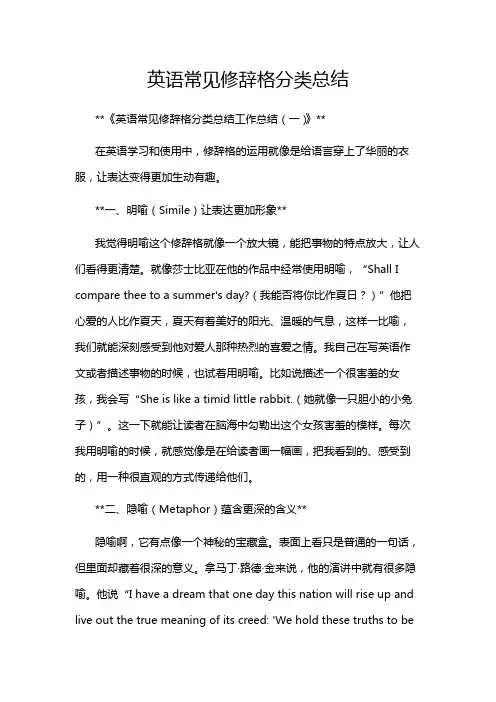
英语常见修辞格分类总结**《英语常见修辞格分类总结工作总结(一)》**在英语学习和使用中,修辞格的运用就像是给语言穿上了华丽的衣服,让表达变得更加生动有趣。
**一、明喻(Simile)让表达更加形象**我觉得明喻这个修辞格就像一个放大镜,能把事物的特点放大,让人们看得更清楚。
就像莎士比亚在他的作品中经常使用明喻,“Shall I compare thee to a summer's day?(我能否将你比作夏日?)”他把心爱的人比作夏天,夏天有着美好的阳光、温暖的气息,这样一比喻,我们就能深刻感受到他对爱人那种热烈的喜爱之情。
我自己在写英语作文或者描述事物的时候,也试着用明喻。
比如说描述一个很害羞的女孩,我会写“S he is like a timid little rabbit.(她就像一只胆小的小兔子)”。
这一下就能让读者在脑海中勾勒出这个女孩害羞的模样。
每次我用明喻的时候,就感觉像是在给读者画一幅画,把我看到的、感受到的,用一种很直观的方式传递给他们。
**二、隐喻(Metaphor)蕴含更深的含义**隐喻啊,它有点像一个神秘的宝藏盒。
表面上看只是普通的一句话,但里面却藏着很深的意义。
拿马丁·路德·金来说,他的演讲中就有很多隐喻。
他说“I have a dream that one da y this nation will rise up and live out the true meaning of its creed: 'We hold these truths to beself - evident, that all men are created equal.'(我有一个梦想,有一天这个国家会站起来,实现其信条的真正含义:我们认为这些真理是不言而喻的,即人人生而平等。
)”这里把美国这个国家的发展隐喻为一个人的“站起来”,暗示着国家走向平等和正义。
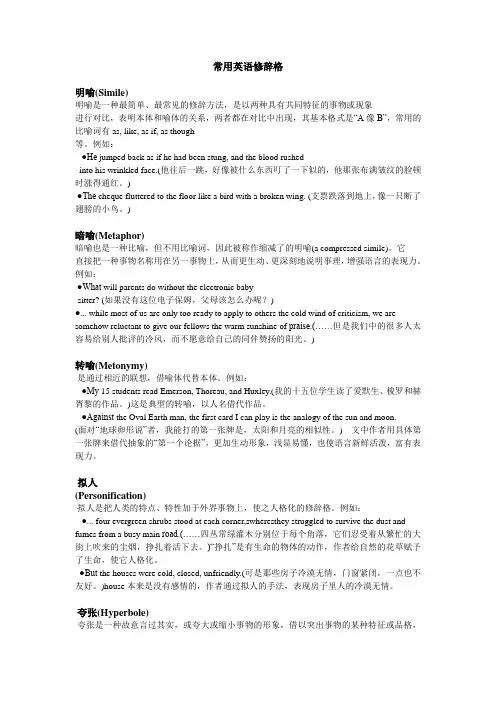
常用英语修辞格明喻(Simile)明喻是一种最简单、最常见的修辞方法,是以两种具有共同特征的事物或现象进行对比,表明本体和喻体的关系,两者都在对比中出现,其基本格式是“A像B”,常用的比喻词有as, like, as if, as though等。
例如:●He jumped back as if he had been stung, and the blood rushedinto his wrinkled face.(他往后一跳,好像被什么东西叮了一下似的,他那张布满皱纹的脸顿时涨得通红。
)●The cheque fluttered to the floor like a bird with a broken wing. (支票跌落到地上,像一只断了翅膀的小鸟。
)暗喻(Metaphor)暗喻也是一种比喻,但不用比喻词,因此被称作缩减了的明喻(a compressed simile)。
它直接把一种事物名称用在另一事物上,从而更生动、更深刻地说明事理,增强语言的表现力。
例如:●What will parents do without the electronic baby-sitter? (如果没有这位电子保姆,父母该怎么办呢?)●... while most of us are only too ready to apply to others the cold wind of criticism, we are somehow reluctant to give our fellows the warm sunshine of praise.(……但是我们中的很多人太容易给别人批评的冷风,而不愿意给自己的同伴赞扬的阳光。
)转喻(Metonymy)是通过相近的联想,借喻体代替本体。
例如:●My 15 students read Emerson, Thoreau, and Huxley.(我的十五位学生读了爱默生、梭罗和赫胥黎的作品。
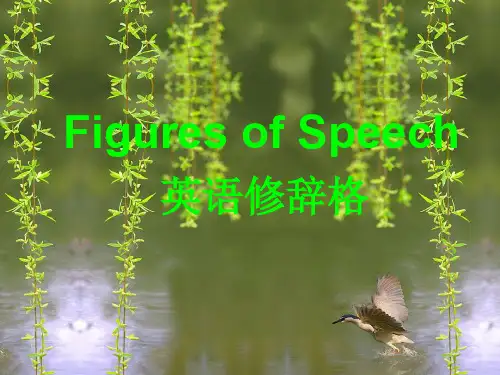
大学英语修辞格大学英语常见修辞格所谓修辞是指依据题旨情境恰当地选择语言手段和表达方式, 以有效地表情达意。
修辞的目的是使作品更加形象生动、引人入胜。
了解英语中的修辞, 有助于我们更好地理解、欣赏文章,也有助于在写作中丰富我们自己的表达。
英语修辞格按其构成大致可以分为三类:(一)词义修辞格(Lexical Rhetorical Devices)词义修辞格主要是指借助语义的联想和语言的变化等特点创造出来的修辞手法。
大学英语中常见的词义修辞格有以下几种:1. Simile 明喻与汉语的明喻基本相同,是以两种具有相同特征的事物和现象进行对比,表明本体和喻体之间的相似关系。
常用来表示明喻的喻词有like, as, as if, as though等。
如:Learning is like rowing upstream; not to advance is to drop back. 学如逆水行舟,不进则退。
2. Metaphor 暗喻暗喻也是一种比喻, 但不用比喻词, 因此被称为"缩减了的明喻(a compressed simile)"。
它是根据两个事物间的某些共同的特征, 用一事物去暗示另一事物的比喻方式。
如:And yet, while most of us are only too ready to apply to others the cold wind of criticism, we are somehow reluctant to give our fellows the warm sunshine of praise. 但是,尽管我们中的很多人太容易给别人批评的冷风,却不知何故不愿意给我们的同伴赞扬的阳光。
(该句中,将criticism比喻成cold wind,将praise比喻成warm sunshine,但是未使用任何比喻词,因此为暗喻。
)3. Metonymy转喻/借代转喻类似于汉语中的借代修辞,是通过相近的联想, 借喻体代替本体,它根本不说出本体事物, 直接用比喻事物代替本体事物。
英语常见的修辞格Figures of speech (修辞)are ways of making our language figurative. When we use words in other than their ordinary or literal sense to lend force to an idea, to heighten effect, or to create suggestive imagery, we are said to be speaking or writing figuratively. Now we are going to talk about some common forms of figures of speech.1) Simile:(明喻)It is a figure of speech which makes a comparison between two unlike elements having at least one quality or characteristic (特性)in common. To make the comparison, words like as, as...as, as if and like are used to transfer the quality we associate with one to the other. For example, As cold waters to a thirsty soul, so is good news from a far country.2) Metaphor:(暗喻)It is like a simile, also makes a comparison between two unlike elements, but unlike a simile, this comparison is implied rather than stated. For example, the world is a stage.3) Analogy: (类比)It is also a form of comparison, but unlike simile or metaphor which usually uses comparison on one point of resemblance, analogy draws a parallel between two unlike things that have several common qualities or points of resemblance.4) Personification: (拟人)It gives human form of feelings to animals, or life and personal attributes(赋予) to inanimate(无生命的) objects, or to ideas and abstractions(抽象). For example, the wind whistled through the trees.5) Hyperbole: (夸张)It is the deliberate use of overstatement or exaggeration to achieve emphasis. For instance, he almost died laughing.6) Understatement: (含蓄陈述)It is the opposite of hyperbole, or overstatement. It achieves its effect of emphasizing a fact by deliberately(故意地) understating it, impressing the listener or the reader more by what is merely implied or left unsaid than by bare statement. For instance, It is no laughing matter.7) Euphemism: (委婉)It is the substitution of an agreeable or inoffensive(无冒犯) expression for one that may offend or suggest something unpleasant. For instance, we refer to "die" as " pass away".8) Metonymy (转喻)It is a figure of speech that has to do with the substitution of the mane of one thing for that of another. For instance, the pen (words) is mightier than the sword (forces).9) Synecdoche (提喻)It is involves the substitution of the part for the whole, or the whole for the part. For instance, they say there's bread and work for all. She was dressed in silks.10) Antonomasia (换喻)It has also to do with substitution. It is not often mentioned now, though it is still in frequent use. For example, Solomon for a wise man. Daniel for a wise and fair judge. Judas for a traitor.11) Pun: (双关语)It is a play on words, or rather a play on the form and meaning of words. For instance,a cannon-ball took off his legs, so he laid down his arms. (Here "arms" has two meanings: a person's body; weapons carried by a soldier.)12) Syllepsis: (一语双叙)It has two connotations.In the first case, it is a figure by which a word, or a particular form or inflection of a word, refers to two or more words in the same sentence, while properly applying to or agreeing with only on of them in grammar or syntax(句法). For example, He addressed you and me, and desired us to follow him. (Here us is used to refer to you and me.)In the second case, it a word may refer to two or more words in the same sentence. For example, while he was fighting , and losing limb and mind, and dying, others stayed behind to pursue education and career. (Here to losing one's limbs in literal; to lose one's mind is figurative, and means to go mad.)13) Zeugma: (轭式搭配)It is a single word which is made to modify or to govern two or more words in the same sentence, wither properly applying in sense to only one of them, or applying to them in different senses. For example, The sun shall not burn you by day, nor the moon by night. (Here noon is not strong enough to burn)14) Irony: (反语)It is a figure of speech that achieves emphasis by saying the opposite of what is meant, the intended meaning of the words being the opposite of their usual sense. For instance, we are lucky, what you said makes me feel real good.15) Innuendo: (暗讽)It is a mild form of irony, hinting in a rather roundabout (曲折)way at something disparaging(不一致) or uncomplimentary(不赞美) to the person or subject mentioned. For example, the weatherman said it would be worm. He must take his readings in a bathroom.16) Sarcasm: (讽刺)It Sarcasm is a strong form of irony. It attacks in a taunting and bitter manner, and its aim is to disparage, ridicule and wound the feelings of the subject attacked. For example, laws are like cobwebs, which may catch small flies, but let wasps break through.17) Paradox: (似非而是的隽语)It is a figure of speech consisting of a statement or proposition which on the face of it seems self-contradictory, absurd or contrary to established fact or practice, but which on further thinking and study may prove to be true, well-founded, and even to contain a succinct point. For example more haste, less speed.18) Oxymoron: (矛盾修饰)It is a compressed paradox, formed by the conjoining(结合) of two contrasting, contradictory or incongruous(不协调) terms as in bitter-sweet memories, orderly chaos(混乱) and proud humility(侮辱).19) Antithesis: (对照)It is the deliberate arrangement of contrasting words or ideas in balanced structural forms to achieve emphasis. For example, speech is silver; silence is golden.20) Epigram: (警句)It states a simple truth pithily(有利地) and pungently(强烈地). It is usually terse and arouses interest and surprise by its deep insight into certain aspects of human behavior or feeling. For instance, Few, save the poor, feel for the poor.21) Climax: (渐进)It is derived from the Greek word for "ladder" and implies the progression of thought at a uniform or almost uniform rate of significance or intensity, like the steps of a ladder ascending evenly. For example, I came, I saw, I conquered.22) Anti-climax or bathos: (突降)It is the opposite of Climax. It involves stating one's thoughts in a descending order of significance or intensity, from strong to weak, from weighty to light or frivolous. For instance, But thousands die, without or this or that, die, and endow(赋予) a college, or a cat.23) Apostrophe:(顿呼)In this figure of speech, a thing, place, idea or person (dead or absent) is addressed as if present, listening and understanding what is being said. For instance, England! awake! awake! awake!24) Transferred Epithet: (转类形容词)It is a figure of speech where an epithet (an adjective or descriptive phrase) is transferred from the noun it should rightly modify(修饰) to another to which it does not really apply or belong. For instance, I spent sleepless nights on my project.25) Alliteration: (头韵)It has to do with the sound rather than the sense of words for effect. It is a device that repeats the same sound at frequent intervals(间隔) and since the sound repeated is usually the initial consonant sound, it is also called "front rhyme". For instance, the fair breeze blew, the white foam flew, the furrow followed free.26) Onomatopoeia: (拟声)It is a device that uses words which imitate the sounds made by an object (animate or inanimate), or which are associated with or suggestive(提示的) of some action or movement. 英语修辞大全,英语作文常用修辞手法1. 比喻(metaphor)比喻就是打比方。
An Introduction to Figures of Speech(修辞格)Rhetorical Devices(修辞手法)1. Simile(明喻)Simile is an expression of comparison between two different things. It is usually introduced by “as” or “like”, and sometimes also by “as…as/as…so”, and “resemble” as the signs of comparison.明喻就是打比方,指一事物像另一事物的修辞格。
常用的比喻词有“as”or “like”, and sometimes also by “as…so /as…as”, and “resemble”等1). Mercy drops as the gentle rain from heaven upon the place beneath.—Shakespeare2). The cheque fluttered to the floor like a bird with a broken wing.3). Self-criticism is as necessary to us as air to water.4). As a man whispers, so the breeze makes a low, hissing sound.5) Learning resembles scaling the heights.2. Metaphor(隐喻/暗喻)Metaphor contains an implied comparison, in which a word or phrase ordinarily or primarily used of one thing is applied to another. In other words, it calls one thing by the name of another or one thing is described in terms of another.隐喻是一种隐含着比喻的修辞格,它直接把一种事物比为另一种事物,不用比喻词,通常比较含蓄。